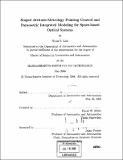| dc.contributor.advisor | David W. Miller. | en_US |
| dc.contributor.author | Lim, Ryan S. (Ryan Seungwook) | en_US |
| dc.contributor.other | Massachusetts Institute of Technology. Dept. of Aeronautics and Astronautics. | en_US |
| dc.date.accessioned | 2007-01-10T16:41:15Z | |
| dc.date.available | 2007-01-10T16:41:15Z | |
| dc.date.copyright | 2006 | en_US |
| dc.date.issued | 2006 | en_US |
| dc.identifier.uri | http://hdl.handle.net/1721.1/35574 | |
| dc.description | Thesis (S.M.)--Massachusetts Institute of Technology, Dept. of Aeronautics and Astronautics, 2006. | en_US |
| dc.description | Includes bibliographical references (p. 155-158). | en_US |
| dc.description.abstract | The quest for higher sensitivity and finer angular resolution in astronomy demands larger and more complex space imaging systems. This thesis presents the concepts developed for two different technologies that have the potential to contribute in improving the performance of space imaging systems. The first technology is precision pointing control technology, which can provide fine optical control operating in conjunction with coarse formation flying attitude control in order to meet the stringent optical requirements. This will potentially enable a long baseline Formation Flying Interferometer (FFI) such as NASA's Terrestrial Planet Finder (TPF). The concept for precision pointing control was realized by a testbed called the Precision Pointing Optical Payload (PPOP). The design and implementation of the PPOP are described, followed by an experimental demonstration of staged pointing control. The global metrology system of the Synchronized Position Hold Engage Reorient Experimental Satellites (SPHERES) provides coarse attitude control, whereas the PPOP provides fine pointing control using a set of fast steering mirrors. The second technology investigates parametric integrated modeling of space telescopes. | en_US |
| dc.description.abstract | (cont.) This technology provides a design tool for examining alternative telescope architectures and identifying favorable architectures at an early stage of the design lifecycle. The MIT Space Systems Laboratory (MIT-SSL) is currently developing a parametric integrated model for a Modular Optical Space Telescope (MOST). This thesis provides an overview of the MOST model, with emphasis on the development of the optics sub-model. ZEMAX is used for calculating the wave front error based on the Zernike sensitivity analysis. A data interface between ZEMAX and MATLAB has been developed, which makes the process of performing the Zernike sensitivity analysis automated. | en_US |
| dc.description.statementofresponsibility | by Ryan S. Lim. | en_US |
| dc.format.extent | 158 p. | en_US |
| dc.format.extent | 8872484 bytes | |
| dc.format.extent | 9462463 bytes | |
| dc.format.mimetype | application/pdf | |
| dc.format.mimetype | application/pdf | |
| dc.language.iso | eng | en_US |
| dc.publisher | Massachusetts Institute of Technology | en_US |
| dc.rights | M.I.T. theses are protected by copyright. They may be viewed from this source for any purpose, but reproduction or distribution in any format is prohibited without written permission. See provided URL for inquiries about permission. | en_US |
| dc.rights.uri | http://dspace.mit.edu/handle/1721.1/7582 | |
| dc.subject | Aeronautics and Astronautics. | en_US |
| dc.title | Staged attitude-metrology pointing control and parametric integrated modeling for space-based optical systems | en_US |
| dc.type | Thesis | en_US |
| dc.description.degree | S.M. | en_US |
| dc.contributor.department | Massachusetts Institute of Technology. Department of Aeronautics and Astronautics | |
| dc.identifier.oclc | 74278164 | en_US |
